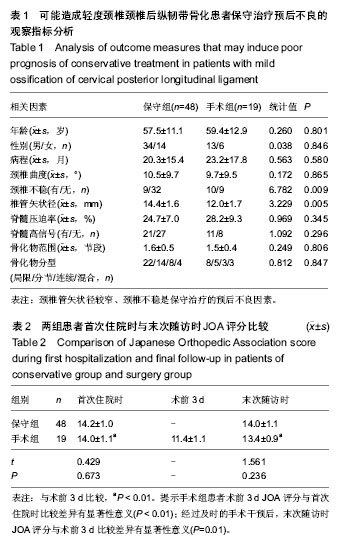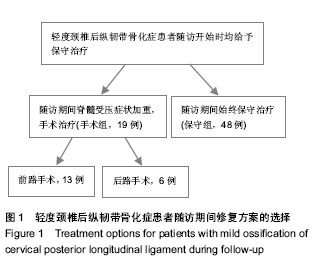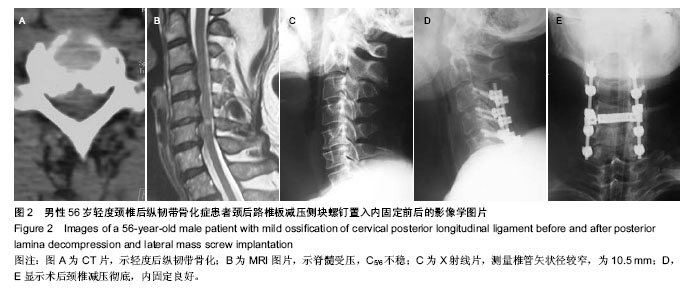| [1] Yoshii T, Yamada T, Hirai T, et al. Dynamic changes in spinal cord compression by cervical ossification of the posterior longitudinal ligament evaluated by kinematic computed tomography myelography. Spine (Phila Pa 1976). 2014;39(2): 113-119.
[2] Fujimori T, Iwasaki M, Okuda S, et al. Long-term results of cervical myelopathy due to ossification of the posterior longitudinal ligament with an occupying ratio of 60% or more. Spine (Phila Pa 1976). 2014;39(1):58-67.
[3] Izumi T, Hirano T, Watanabe K, et al. Three-dimensional evaluation of volume change in ossification of the posterior longitudinal ligament of the cervical spine using computed tomography. Eur Spine J. 2013;22(11):2569-2274.
[4] 贾连顺.颈椎后纵韧带骨化并不都需要手术[J]. 中国矫形外科杂志, 2009,17(7): 47-49.
[5] Sah S, Wang L, Dahal M, et al. Surgical management of cervical spondylotic myelopathy. J Nepal Med Assoc. 2012; 52(188):172-177.
[6] Pham MH, Attenello FJ, Lucas J, et al. Conservative management of ossification of the posterior longitudinal ligament. A review. Neurosurg Focus. 2011;30(3):E2.
[7] Matsunaga S, Sakou T, Taketomi E, et al. The natural course of myelopathy caused by ossification of the posterior longitudinal ligament in the cervicalspine. Clin Orthop Relat Res. 1994; 8(305):168-177.
[8] Matsumoto M, Toyama Y, Ishikawa M, et al. Increased signal intensity of the spinal cord on magnetic resonance images in cervical compressive myelopathy. Does it predict the outcome of conservative treatment? Spine (Phila Pa 1976). 2000;25(6): 677-682.
[9] Wilson JR, Barry S, Fischer DJ, et al. Frequency, timing, and predictors of neurological dysfunction in the nonmyelopathic patient withcervical spinal cord compression, canal stenosis, and/or ossification of the posterior longitudinal ligament.Spine (Phila Pa 1976).2013;38(22 Suppl 1):S37-54.
[10] Mochizuki M, Aiba A, Hashimoto M, et al. Cervical myelopathy in patients with ossification of the posterior longitudinal ligament. J Neurosurg Spine. 2009;10(2): 122-128.
[11] Wu JC, Liu L, Chen YC, et al. Ossification of the posterior longitudinal ligament in the cervical spine: an 11-year comprehensive national epidemiology study. Neurosurg Focus. 2011;30(3):E5.
[12] Xing D, Wang J, Ma JX, et al. Qualitative evidence from a systematic review of prognostic predictors for surgical outcomes followingcervical ossification of the posterior longitudinal ligament. J Clin Neurosci. 2013;20(5):625-633.
[13] Li H, Jiang LS, Dai LY. A review of prognostic factors for surgical outcome of ossification of the posterior longitudinal ligament ofcervical spine. Eur Spine J. 2008; 17(10): 1277-1288.
[14] Hyun SJ, Riew KD, Rhim SC. Range of motion loss after cervical laminoplasty: a prospective study with minimum 5-year follow-up data. Spine J. 2013;13(4):384-390.
[15] Matsuyama Y, Kawakami N, Yanase M, et al. Cervical myelopathy due to OPLL: clinical evaluation by MRI and intraoperative spinal sonography. J Spinal Disord Tech. 2004; 17(5):401-404.
[16] Vedantam A, Jonathan A, Rajshekhar V. Association of magnetic resonance imaging signal changes and outcome prediction after surgery forcervical spondylotic myelopathy. J Neurosurg Spine. 2011;15(6):660-666.
[17] Kimura A, Seichi A, Hoshino Y, et al. Perioperative complications of anterior cervical decompression with fusion in patients with ossification of the posterior longitudinal ligament: a retrospective, multi-institutional study. J Orthop Sci. 2012;17(6):667-672.
[18] Fujimori T, Iwasaki M, Nagamoto Y, et al. Three-dimensional measurement of intervertebral range of motion in ossification of the posterior longitudinal ligament: are there mobile segments in the continuous type? J Neurosurg Spine. 2012;17(1):74-81.
[19] Odate S, Shikata J, Kimura H, et al. Anterior corpectomy with fusion in combination with an anterior cervical plate in the management of ossification of the posterior longitudinal ligament. J Spinal Disord Tech. 2012;25(3):133-137.
[20] Nakamura K, Kurokawa T, Hoshino Y, et al. Conservative treatment for cervical spondylotic myelopathy: achievement and sustainability of a level of “no disability”. J Spinal Disord. 1998;11(2):175-179.
[21] Epstein N. Posterior approaches in the management of cervical spondylosis and ossification of the posterior longitudinal ligament. Surg Neurol. 2002;58(3-4):194-208.
[22] 陈德玉.颈椎后纵韧带骨化症的治疗现状[J].中国脊柱脊髓杂志, 2010, 20(3):181-183.
[23] Sun Q, Hu H, Zhang Y, et al. Do intramedullary spinal cord changes in signal intensity on MRI affect surgical opportunity and approach for cervical myelopathy due to ossification of the posterior longitudinal ligament? Eur Spine J. 2011;20(9): 1466-1473.
[24] Yonenobu K. Is surgery indicated for asymptomatic or mildly myelopathic patients with significant ossification of the posterior longitudinal ligament? Spine (Phila Pa 1976). 2012; 37(5):E315-317.
[25] Tsuyama N. Ossification of the posterior longitudinal ligament of the spine. Clin Orthop Relat Res. 1984; (184):71-84.
[26] Harsh GR 4th, Sypert GW, Weinstein PR, et al. Cervical spine stenosis secondary to ossification of the posterior longitudinal ligament. J Neurosurg. 1987;67(3):349-357.
[27] Nurick S. The pathogenesis of the spinal cord disorder associated with cervical spondylosis. Brain. 1972;95(1):87-100.
[28] 陈宇,陈德玉,王新伟,等.严重颈椎后纵韧带骨化症前路和后路手术比较[J].中华骨科杂志,2008, 28(9):705-709.
[29] 申勇,王林峰,张英泽,等. MRI信号强度及临床表现对判断颈椎后纵韧带骨化症预后的作用[J].中华骨科杂志, 2009, 29(3): 212-215.
[30] Ogawa Y, Chiba K, Matsumoto M, et al. Long-term results after expansive open-door laminoplasty for the segmental-type of ossification of the posterior longitudinal ligament of the cervical spine: a comparison with nonsegmental-type lesions. J Neurosurg Spine. 2005;3(3): 198-204.
[31] Choi S, Lee SH, Lee JY, et al. Factors affecting prognosis of patients who underwent corpectomy and fusion for treatment of cervical ossification of the posterior longitudinal ligament: analysis of 47 patients. J Spinal Disord Tech. 2005;18(4): 309-314.
[32] Oshima Y, Seichi A, Takeshita K, et al. Natural course and prognostic factors in patients with mild cervical spondylotic myelopathy with increased signal intensity on T2-weighted magnetic resonance imaging. Spine (Phila Pa 1976). 2012; 37(22):1909-1913. |


